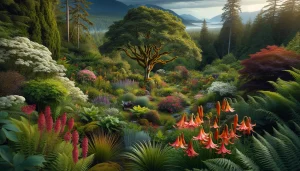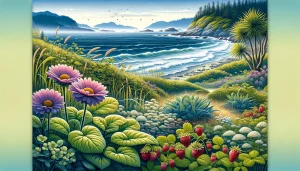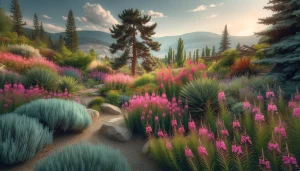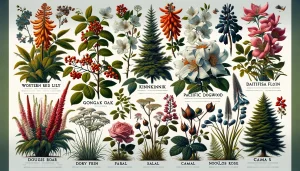Native plants echo the local landscape in the heart of every garden, bringing the unique beauty and ecological balance of British Columbia’s natural habitats into our personal spaces. Additionally, cultivating native plants is not just an aesthetic choice; it’s a step towards creating a more sustainable and wildlife-friendly garden. Moreover, here, we explore the myriad benefits of native plants, offer insights on selecting and sourcing them, and spotlight the top ten native plants for British Columbia gardens.

Ecological Benefits: Beyond Beauty
Native plants are more than pretty faces in the garden; they are the backbone of local ecosystems. Adapted to the region’s climate, soil, and environmental conditions, these plants require less water and fewer fertilizers than their non-native counterparts. Furthermore, they support local wildlife, including birds, bees, butterflies, and beneficial insects, providing them with necessary habitat and food resources. For example, the Western Red Lily, British Columbia’s emblematic flower, is not only a stunning sight but also attracts a variety of pollinators.

Selecting and Sourcing Native Plants
Choosing native plants for your garden begins with understanding the specific conditions of your garden space and the native flora that thrives in those conditions. Whether your garden is shaded, sunny, wet, or dry, there’s a native plant that can flourish there. Consequently, local nurseries specializing in native plants can offer advice tailored to British Columbia’s diverse climates, from the coastal rainforests to the arid interior.

A Showcase of Diversity: Gardens Across British Columbia
From the rugged shores of the Pacific to the serene landscapes of the Okanagan Valley, gardens across British Columbia can benefit immensely from native plants. In particular, coastal gardens can harness the salt-tolerant Seaside Daisy and Beach Strawberry, while inland gardens might feature the drought-resistant Ponderosa Pine or the vibrant Fireweed.

Top Ten Native Plants for British Columbia Gardens
- Western Red Lily (Lilium columbianum) – A striking orange flower that’s a magnet for hummingbirds and butterflies.
- Pacific Dogwood (Cornus nuttallii) – British Columbia’s floral emblem, showcasing magnificent white blooms in spring.
- Kinnikinnick (Arctostaphylos uva-ursi) – A hardy groundcover with pink bell-shaped flowers and red berries.
- Garry Oak (Quercus garryana) – A majestic tree providing critical habitat for hundreds of species.
- Sword Fern (Polystichum munitum) – An evergreen fern that thrives in the understory of forests.
- Douglas Fir (Pseudotsuga menziesii) – A towering evergreen, pivotal to the region’s forest ecosystems.
- Salal (Gaultheria shallon) – A versatile shrub with dark green foliage and edible berries.
- Nootka Rose (Rosa nutkana): This rose offers fragrant blooms and, with its thorny stems, serves as a barrier plant.
- Camas (Camassia quamash)—Produces stunning blue flowers. It was historically significant as a food source for Indigenous peoples.
- Red Osier Dogwood (Cornus sericea) – Known for its vibrant winter red stems and white spring flowers.
By incorporating these native plants into your garden, you enhance its beauty and contribute to conserving British Columbia’s natural heritage. Subsequently, by creating a garden that supports and includes native species, you’re providing a refuge for local wildlife and taking a step towards a more sustainable future.
In conclusion, integrating native plants into our gardens is a powerful testament to the beauty and resilience of British Columbia’s natural landscapes. By choosing natives, we not only celebrate the unique character of our region but also contribute to the health and sustainability of our local ecosystems. Lastly, whether you’re a seasoned gardener or just beginning to green your thumbs, the diversity and adaptability of native plants offer endless possibilities for enriching your garden and connecting with the natural world around you.